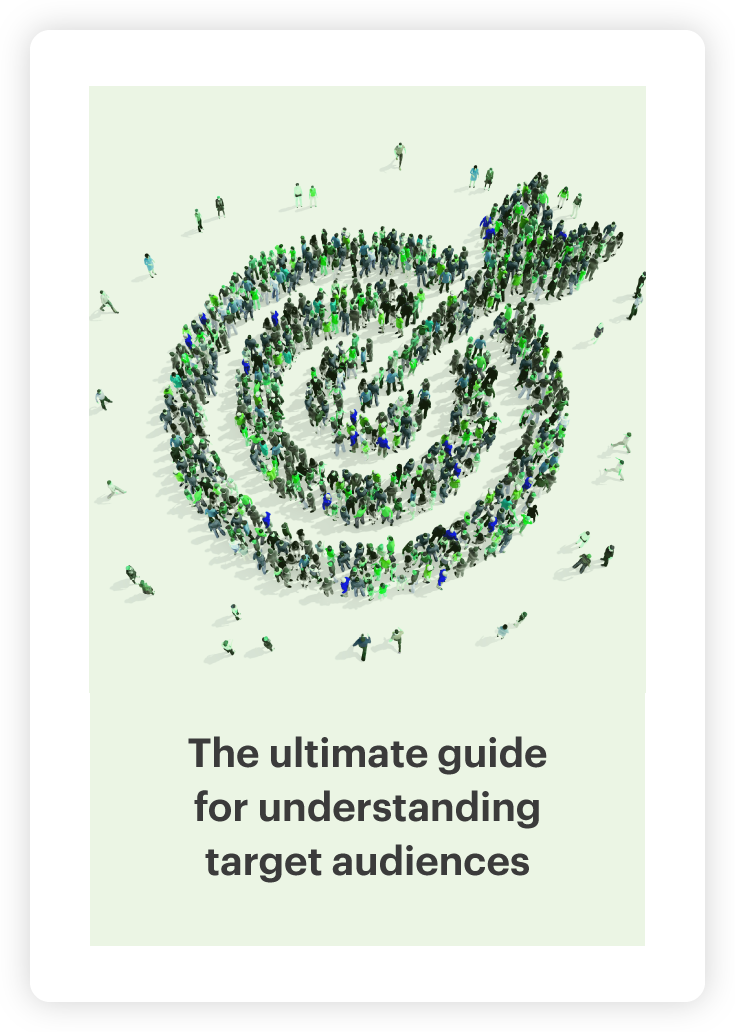How do reviews of TV shows with diverse casting compare to those without?

In 2015, Viola Davis made history and became the first woman of color to win an Emmy for Best Actress in a Drama Series. When accepting the award, Davis stated: “The only thing that separates women of color from anyone else is opportunity. You cannot win an Emmy for roles that are simply not there.” In this speech, she shed light on the fact that diverse casting and representation had been lacking for decades.
Although the film and TV industry still remains disproportionately white, efforts are being made to improve diversity. In recent years, there’s been an influx of TV shows and movies giving voice to underrepresented groups – both on-screen and behind the scenes. Having a diverse cast and crew is becoming a key consideration for production companies.
Being in the world of research, we wanted to find out how the presence of diversity influences audience perceptions and reviews of TV series. To do this, we used Relative Insight’s text analytics platform to compare IMDb reviews of TV shows with diverse casting (racially and ethnically diverse, LGBTQ+ characters, etc.) to those without.
The TV shows which we analyzed varied along the spectrum of representation. Bridgerton, Euphoria, Pose, Never Have I Ever, Sex Education, Power and It’s a Sin all feature diverse casts. While the likes of Sex and the City, Friends, How I Met Your Mother, Succession and Arrested Development do not. This form of analysis reveals unique audience insights highlighting what resonates most with viewers for each show, as well as unveiling how diversity in TV can impact perceptions.
Reviews of shows with diverse casting
Educational
Having a variety of storylines and diverse casting onscreen pays tribute to the diverse world in which we live. It helps to broaden people’s knowledge of different narratives and personal experiences. In our analysis, we found viewers were 3.9x more likely to talk about the educational aspects of TV shows with a diverse cast. Words such as learning, educating and understanding appeared more throughout this set of reviews, highlighting the informative power of media.
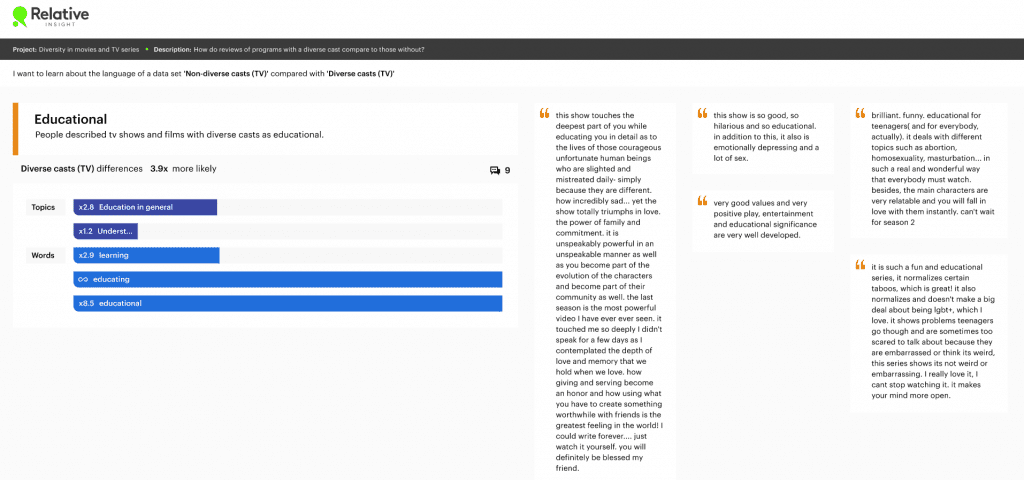
Authentic
We also found that reviews of TV shows with diverse casting were 2.9x more likely to describe performances and storylines as authentic, realistic and accurate compared to less diverse shows. What’s clear is that audiences want authenticity. They want to see realistic depictions of characters onscreen, not offensive stereotypes. While certain genres may deviate from reality, genuine representation is still necessary in the eyes of viewers.
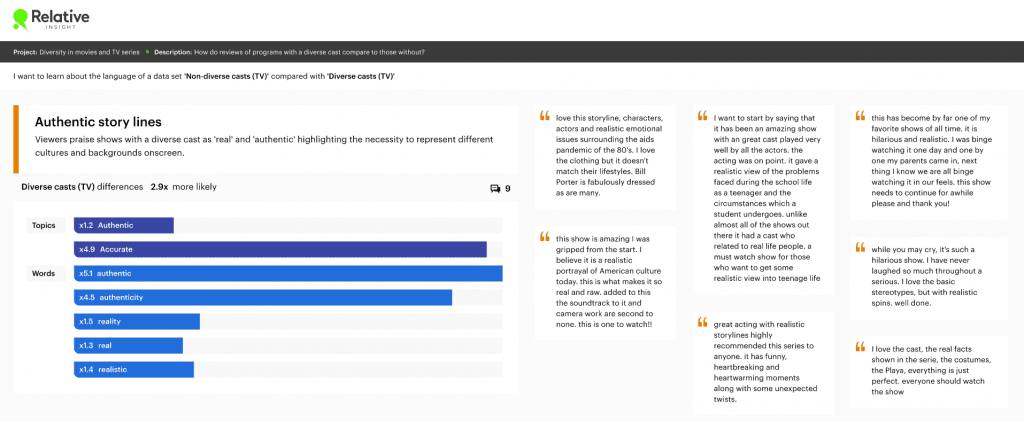
Brave and bold
Viewers were more positive about shows with diverse casting, praising the likes of Sex Education, It’s A Sin and Bridgeton for their boldness and bravery. While this insight illustrates the positive reception of diverse casting, these words also carry a duality in their meaning. They demonstrate that there is still a long way to go before underrepresented narratives are considered the norm, rather than brave or unexpected.
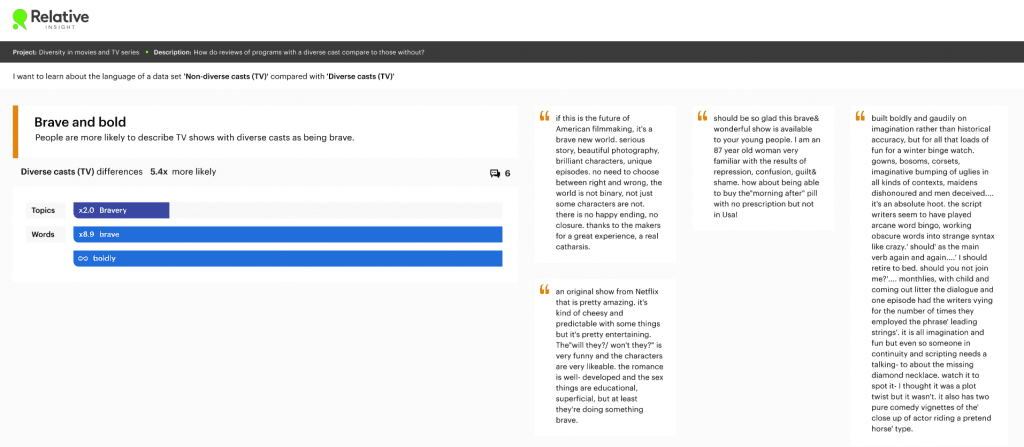
Another audience insight that we discovered was that reviews of shows that featured diverse casting were more emotional. Our analysis identified emotions such as fear, sadness, frustration, contentment, worry and bravery throughout this data – whereas only two emotions were detected in reviews of shows with a non-diverse cast.
As expected, people evaluating diverse TV shows did in fact mention diversity and representation. This only goes to strengthen the point that audiences want to see a greater variety of backgrounds onscreen. And when entertainment companies get it right, viewers give them credit for it.
Reviews of shows with a non-diverse cast
Overrated
In contrast, reviews of TV shows that lacked diverse casting were 8.1x more likely to be described as overrated. People claimed to have never understood the hype around the likes of Friends, How I Met Your Mother or Succession, often referring to the homogeneity of plots and characters.

Light-hearted
Rather than mentioning any educational or relatable aspects of these non-diverse casts, audiences discussed which characters were annoying, whiny or the funniest. This implies that viewers form their opinions based on behaviors or personality traits, as opposed to a character’s intrinsic qualities like racial background, sexual orientation or gender.
The difference in tone between reviews of shows with diverse casting and those without is apparent. Non-diverse shows generate much more light-hearted comments, illustrating how television is often used as a form of escapism or merely an entertaining way to pass the time. The audience watch and enjoy the show despite the absence of representation. Whereas shows that celebrate diversity inspire more emotive and thoughtful responses.
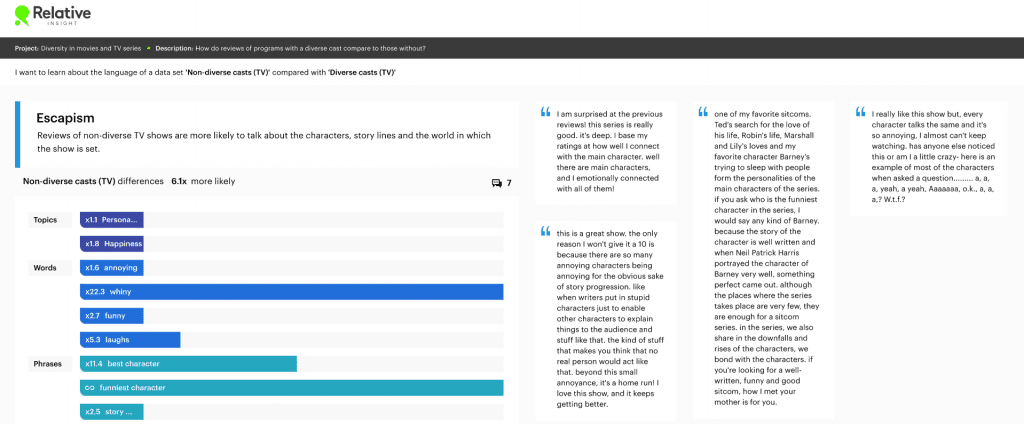
When it comes to diverse casting in TV shows, audiences notice. This analysis gives us a glimpse into what modern viewers want in their entertainment programming. They want production companies to keep opening up space for all kinds of stories to be portrayed, allowing for as much diversity on-screen as there is off.
